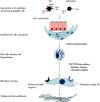The Toxicological Mechanisms of Environmental Soot (Black Carbon) and Carbon Black: Focus on Oxidative Stress and Inflammatory Pathways
- PMID: 28713383
- PMCID: PMC5492873
- DOI: 10.3389/fimmu.2017.00763
The Toxicological Mechanisms of Environmental Soot (Black Carbon) and Carbon Black: Focus on Oxidative Stress and Inflammatory Pathways
Abstract
The environmental soot and carbon blacks (CBs) cause many diseases in humans, but their underlying mechanisms of toxicity are still poorly understood. Both are formed after the incomplete combustion of hydrocarbons but differ in their constituents and percent carbon contents. For the first time, "Sir Percival Pott" described soot as a carcinogen, which was subsequently confirmed by many others. The existing data suggest three main types of diseases due to soot and CB exposures: cancer, respiratory diseases, and cardiovascular dysfunctions. Experimental models revealed the involvement of oxidative stress, DNA methylation, formation of DNA adducts, and Aryl hydrocarbon receptor activation as the key mechanisms of soot- and CB-induced cancers. Metals including Si, Fe, Mn, Ti, and Co in soot also contribute in the reactive oxygen species (ROS)-mediated DNA damage. Mechanistically, ROS-induced DNA damage is further enhanced by eosinophils and neutrophils via halide (Cl- and Br-) dependent DNA adducts formation. The activation of pulmonary dendritic cells, T helper type 2 cells, and mast cells is crucial mediators in the pathology of soot- or CB-induced respiratory disease. Polyunsaturated fatty acids (PUFAs) were also found to modulate T cells functions in respiratory diseases. Particularly, telomerase reverse transcriptase was found to play the critical role in soot- and CB-induced cardiovascular dysfunctions. In this review, we propose integrated mechanisms of soot- and CB-induced toxicity emphasizing the role of inflammatory mediators and oxidative stress. We also suggest use of antioxidants and PUFAs as protective strategies against soot- and CB-induced disorders.
Keywords: air pollution; carbon black; inflammation; oxidative stress; polyunsaturated fatty acids; soot (black carbon).
Figures







Similar articles
-
Soot-driven reactive oxygen species formation from incense burning.Sci Total Environ. 2011 Oct 15;409(22):4781-7. doi: 10.1016/j.scitotenv.2011.07.041. Epub 2011 Sep 3. Sci Total Environ. 2011. PMID: 21889784
-
Oxidative stress induced by ultrafine carbon black particles can elicit apoptosis in vivo and vitro.Sci Total Environ. 2020 Mar 20;709:135802. doi: 10.1016/j.scitotenv.2019.135802. Epub 2019 Dec 17. Sci Total Environ. 2020. PMID: 31887498
-
Accumulation of lipids and oxidatively damaged DNA in hepatocytes exposed to particles.Toxicol Appl Pharmacol. 2014 Jan 15;274(2):350-60. doi: 10.1016/j.taap.2013.10.001. Epub 2013 Oct 11. Toxicol Appl Pharmacol. 2014. PMID: 24121055
-
Evaluating the evidence on genotoxicity and reproductive toxicity of carbon black: a critical review.Crit Rev Toxicol. 2018 Feb;48(2):143-169. doi: 10.1080/10408444.2017.1391746. Epub 2017 Nov 2. Crit Rev Toxicol. 2018. PMID: 29095661 Review.
-
Oxidative stress-induced DNA damage by particulate air pollution.Mutat Res. 2005 Dec 30;592(1-2):119-37. doi: 10.1016/j.mrfmmm.2005.06.012. Epub 2005 Aug 8. Mutat Res. 2005. PMID: 16085126 Review.
Cited by
-
Individual and joint exposures to PM2.5 constituents and mortality risk among the oldest-old in China.Sci China Life Sci. 2024 Oct 10. doi: 10.1007/s11427-024-2718-9. Online ahead of print. Sci China Life Sci. 2024. PMID: 39400872
-
The effects of photochemical aging and interactions with secondary organic aerosols on cellular toxicity of combustion particles.J Aerosol Sci. 2025 Jan;183:106473. doi: 10.1016/j.jaerosci.2024.106473. Epub 2024 Sep 24. J Aerosol Sci. 2025. PMID: 39372219
-
Critical Issues in Assessing Occupational Exposure to Diesel Dust Exhaust.Med Lav. 2024 Aug 27;115(4):e2024029. doi: 10.23749/mdl.v115i4.16100. Med Lav. 2024. PMID: 39189371 Free PMC article.
-
Atmospheric elemental carbon pollution and its regional health disparities in China.Environ Res Lett. 2023 Dec;18(12):124017. doi: 10.1088/1748-9326/ad0862. Epub 2023 Nov 9. Environ Res Lett. 2023. PMID: 39036363 Free PMC article.
-
Speeding Up Time: New Urinary Peptide Clock Associates Greater Air Pollution Exposures with Faster Biological Aging.Environ Health Perspect. 2024 Apr;132(4):44001. doi: 10.1289/EHP14528. Epub 2024 Apr 3. Environ Health Perspect. 2024. PMID: 38568857 Free PMC article.
References
Publication types
LinkOut - more resources
Full Text Sources
Other Literature Sources


